Steemit Crypto Academy | Season 3 | Week 8 - Homework Post For Professor @yohan2on
Hello professor @yohan2on, allow me present to you my homework post that you provided to the steemians after the lecture about Risk management in trading.

Define the following Trading terminologies;
Buy stop.
A buy stop is an order to buy an asset at a specific price above its current market price. By placing a buy stop order, an investor sets the price for buying an asset in advance, which eliminates the danger of missing the price point and the chance to buy an asset that would provide a good return. For example, brayan256 thinks Steem Dollar is going to go in a massive uptrend, so brayan256 sets a buy stop order on Steem Dollar for $10 and it’s currently trading at $8 each and once the price keeps climbing and reaches $10, his order takes effect.
An illustration of a buy stop.
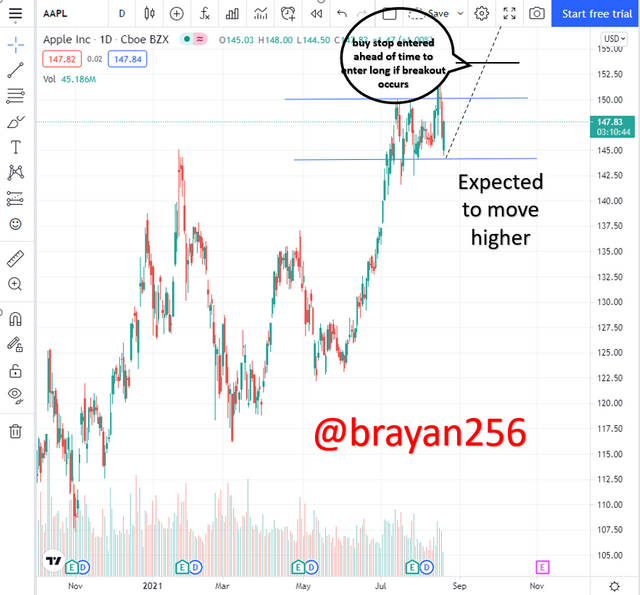
The biggest benefit to buy stop orders is that the investor’s purchase only takes place if the asset’s price is moving in the uptrend and if the investor’s intuition or analysis about a particular asset’s uptrend movement is correct, he or she will be rewarded for his or her initiative and insight. A buy stop order saves time for investors because the deal is ready to get triggered without the investor having to monitor the asset’s price regularly which prevents stress and emotion hence getting the best of the investor’s good sense. The danger with buy stop orders is an investor might set a price that turns out to be the stock’s highest value thus leaving him or her with a negative return.
Sell stop.
A sell stop is a price level set by a trader when they wish to sell their asset in the future, that is to say, the predefined price for the sell stop is always under the contemporary market price of the asset in question.
An illustration of a sell stop.

Buy limit.
A buy limit is an order that happens when a trader places an order to purchase an asset below the set price. The buy limit order allows a trader to limit the amount he or she is willing to pay for an asset. For example, brayan256 wants to buy an asset but does not want to pay more than $25 for the asset, and currently, the asset is trading at $30 so brayan256 places a buy limit order with his broker to purchase the asset at $25. If the asset price drops to $25 or below, his order will be triggered, but if the price continues to go in an uptrend and doesn’t drop to the set price, then his order will not be triggered. Buy limits are considered day orders which means they expire at the end of the trading day and the exception to this is when the buy limit is placed Good Til Cancelled.
An illustration of a buy limit.
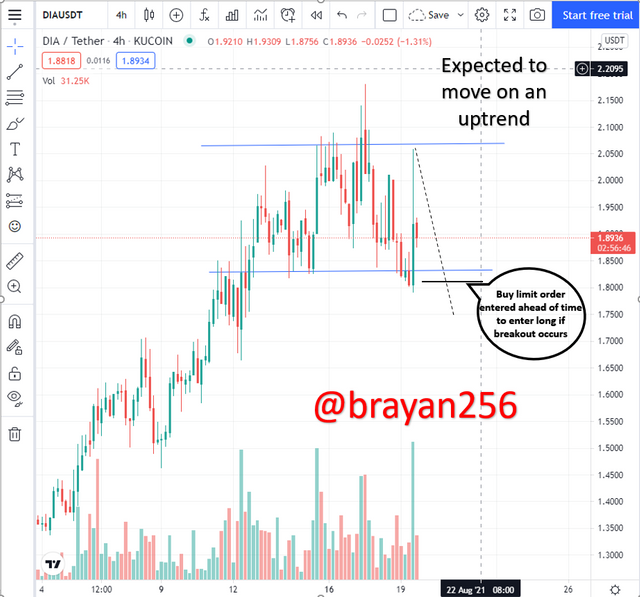
Sell limit.
A sell limit is a type of order in which a trader orders the broker to open sell trade when a trade reaches his or her desired level to sell, that is to say, the key difference between sell limit from sell stop is that the predefined price for the second is always higher than the current market price of the asset.
An illustration of a sell limit.
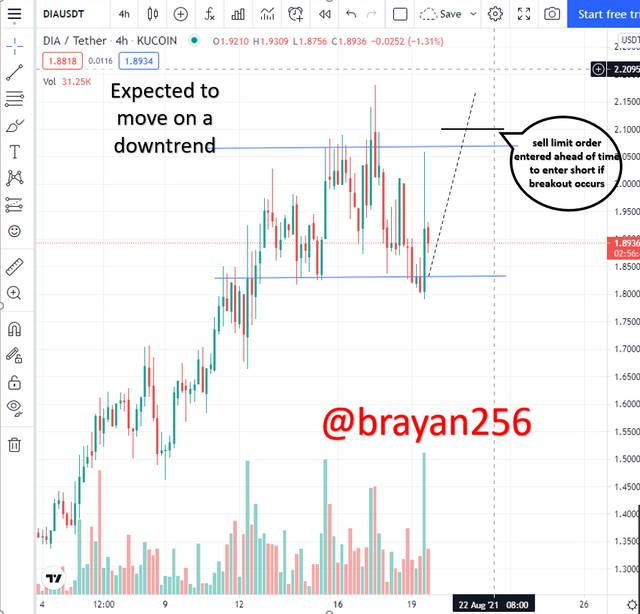
Trailing stop loss.
A trailing stop loss is an order to buy an asset if it moves in an unfavorable direction. Trailing stop loss automatically adjusts to the market price of an asset or stock which provides the investor with a greater possibility to profit or limit a loss. The stop level can be expressed either as a fixed dollar amount or a percentage of an asset’s current price, that is to say, trailing stop loss can also be used for short positions by setting up a trigger price above the contemporary market price.

For example, brayan256 buys steem dollars at $8 each, for protection, brayan256 decides to place a 10% trailing stop loss which means the broker will try to execute a sell of brayan256’s assets if they fall 10% below the peak price after purchase. Because brayan256’s asset is currently worth $8, the trailing stop loss would be triggered if the worth fell to $7. However if the asset price increases to $10, a brokerage would automatically adjust the trigger price to $9 thus reflecting a 10% loss of $10 worth of an asset.
Margin call.
A margin call is provided when the equity in a margin account drops beneath a fixed level. Many brokerages have their margin level requirements, for example, brayan256 buys 50 shares of stock using $5000 of equity and a $5000 loan from the broker. After an extremely poor quarter, the market value of brayan256’s shares drops to $7000 leaving the margin loan still sitting at $5000 but the equity at $2000. If the minimum maintenance requirement is 25% then the equity must not fall below $3000. In this case, the equity has fallen below the minimum maintenance requirement and brayan256 will receive a margin call for $1000 and if this demand isn’t met, the broker can close any of these positions to bring the account up to the minimum maintenance amount. In most cases, the broker has the right to decide what assets to sell and may be able to sell the selected asset without consulting the account holder.
An illustration of one of my margin call alerts.
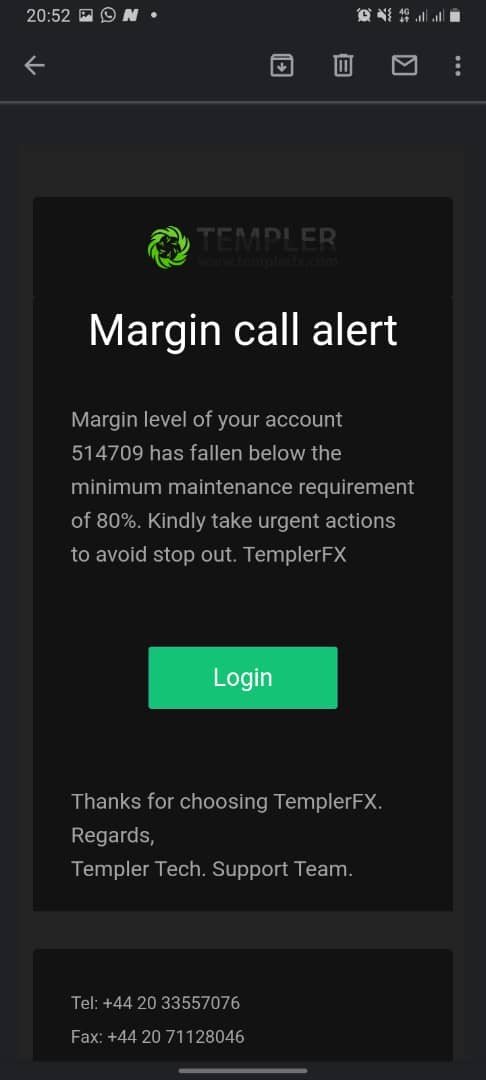
Practically demonstrate your understanding of Risk management in trading.
Risk in the context of the financial market is the potential of a bad outcome including money, underperforming of assets, or failing to achieve your investments or trading goals. Consequently, risk management consists of the controls or rules that are put in place to mitigate these risks, that is to say, risk management is stacking to win more than losing, for example, you should have a risk-reward strategy whereby you win more than lose. There are three main rules that makeup risk management which includes;
Use of stop loss.
When entering the market, a trader should know what the potential risks are in advance, that is to say, traders should know when to exit a losing market which means that they will know in advance how much capital they are willing to risk.
Position sizing.
An important position is figuring out what your risk per trade is going to be, for instance, 1%, 2%, or higher. Once a trader has done that, he or she can specify the number of pips at risk which is the difference in pips between the entry price and the stop loss. Position size is calculated as; position size equals Risk per trade divided by Pips at risk.
Risk reward ratio.
Risk reward ratio means that any potential profits are directly related to how much you are willing to risk. If you follow a 1 : 3 risk-reward ratio then a stop loss of 30 pips implies a profit of 90 pips. Similarly when following a risk-reward ratio of 1 : 2, a 30 pips stop loss implies a 60 pips profit.
Using moving average trading strategy on TWT/USDT 4-hours chart to demonstrate Risk management.
Moving averages is one of the trading indicators that have an extra powerful aspect to gauge the risk of a trade, that is, the cross overs and pullbacks give a trader a perfect indication of both an entry and exit point of a trade. In this task, I will elaborate on risk management using the exponential moving average as shown below.
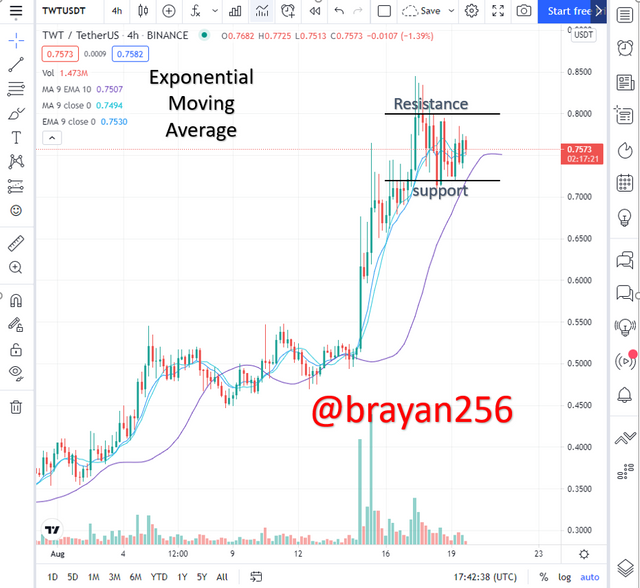
On this 4-hour chart, I plotted a 10-period exponential moving average and the price has moved quite a long way from my 10 periods EMA. We need to be conscious about going long because we know market prices stretch further than expected but as a trader, I will be looking for probabilities. The probability is that price will pull back to the moving average and explode away from the moving average so when I am buying and this movement away from the moving average is too high means I will just be chasing the candle the fact that at some point of time it will carry on and move in the uptrend thus not managing my risk and can easily be caught off guard.
In this case, the best way to manage risk is to wait for the price to reach support because the trend will always pose and the price will contract which will make the moving average catch up with it and you will see some downtrend movement.
Therefore, I would like to thank professor @yohan2on for this wonderful lecture which has greatly improved my understanding of risk management in trading.
Hi
Thanks for participating in the Steemit Crypto Academy
Feedback
This is good content. Well done with your practical study on Risk management.
You have been curated by @yohan2on, a country representative (Uganda). We are curating using the steemcurator04 curator account to support steemians in Africa.
Keep creating good content on Steemit.
Always follow @ steemitblog for updates on steemit